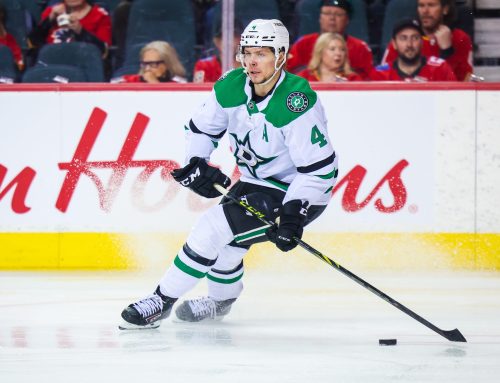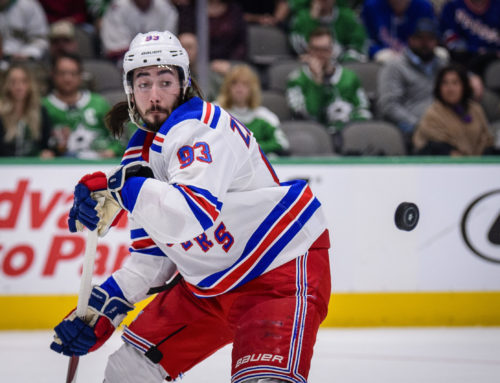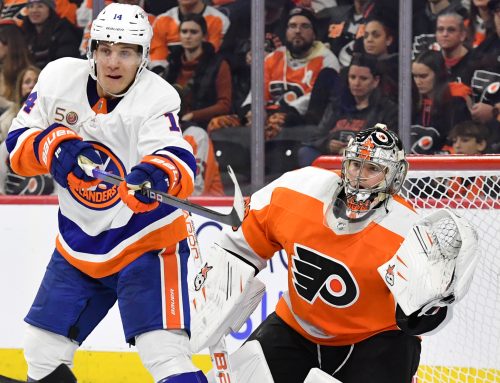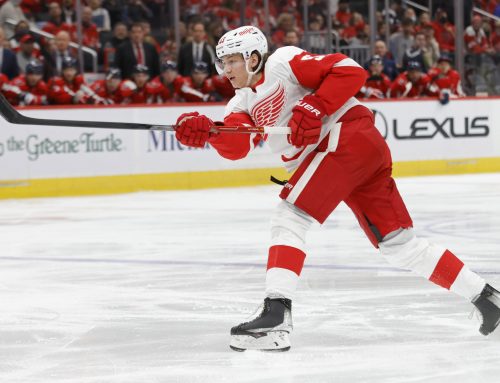Goldipucks and the Three Skaters: Sean Monahan, Dougie Hamilton, and John Tavares
Rick Roos
2019-09-04

It’s time for your monthly fix of “Goldipucks and the Three Skaters.” For first time readers, or those needing a refresher, this column is a play on the Goldilocks and the Three Bears story, except instead of there being three bowls of porridge I’m covering three skaters and declaring one too hot (i.e., doing unsustainably better than he should), another too cold (i.e., doing unsustainably worse), and a third “just right” (i.e., producing where he should be). I also assign each a 1-10 rating, which indicates just how hot (rated 7-10, where 10 is the most unsustainably hot), or how cold (rated 1-4, where 1 is the most unsustainably cold), or how “just right” (rated 4-7, where 5.5 is the most “just right”) he is.
This week’s trio of skaters are Sean Monahan, Dougie Hamilton, and John Tavares. Can you figure out who was too hot, too cold, and “just right” for 2018-19? Give it your best guess then read on!
Sean Monahan
After remarkable consistency (27-31 goals, 31-36 assists, 58-64 points) in his prior four seasons, Monahan posted 82 points in 78 games in 2018-19, fulfilling expectations that had accompanied him since being drafted 6th overall in 2013. And considering Monahan won’t turn 25 until October and will likely remain joined at the hip with superstar Johnny Gaudreau (who posted 99 points in 2018-19), there still has to be room for further improvement, right? The short answer is no; and in fact, Monahan might not taste point per game scoring again in 2019-20 or upcoming seasons.
Looking at Monahan’s scoring in 2018-19 is a tale of two halves, as he posted 55 points in 43 games in the first half on 130 SOG and 13 PPPts, whereas his second half saw him tally 30 points in 35 games on 81 SOG and ten PPPts. What’s more, his ice time dropped with each quarter, starting at 20:14 per game, before sliding to 19:27, then 18:50, and finally to 17:14. It might have been one thing if he was a young player and the team was trying to avoid him hitting a wall, but Monahan was a veteran of 394 career games before 2018-19 even began. And although Gaudreau also shed ice time from the beginning of the season, it was far less drastic (20:44, 20:18, 19:38, 19:44) and, as can be seen, it even rebounded in the fourth quarter such that Gaudreau saw 2:30 more ice time per game than Monahan that quarter.
Overall, Monahan had 211 SOG (no more than 20 above what he had in any of his past four seasons), 23 PPPts (four above the average of his past four seasons), per game ice time per lower than two of his past four seasons, and PP time per game on par with what he had in one of his past three seasons but 21 seconds below 2017-18. Yes, he received a boost in scoring due to his team being better (64 more goals than the average of its past three seasons); but collectively this does not paint a picture of a player who was so consistently a 58-64 point player suddenly jumping to 82 points, especially since Gaudreau, who had a slightly less pronounced jump in scoring of 15 points from 2017-18 to last season, and had a larger increase in SOG, plus a career-best – albeit not by a huge amount – in average ice time per game.
Looking at Monahan’s metrics, there was no increase in IPP or OZ%, nor change in primary/secondary assists rate; and he saw his percentage of PP time drop versus 2017-18. His team shooting percentage at 5×5 for 2018-19 was 10.75%, but it had been 9.75% and 10.18% in two of his previous three seasons. In fact, the only pronounced difference was in his points per 60 minutes rate, which had been 2.3-2.4 for three seasons, jumped to 2.8 in 2017-18, but rose to 3.3 in 2018-19. Yes, some improvement makes sense; but that increase probably is unsustainable given all his data.
Clearly, Monahan’s production will remain above the 58-64 points it had been because he is improving, as is his team; however, it looks as if his 2018-19 full season scoring rate of 86 was TOO HOT due to his downwardly trending ice time and production. I’d expect Monahan to score in the 75-80 point range for 2019-20; as such, he gets a rating of 8.25.
Dougie Hamilton
If we look at Hamilton’s scoring over the past five seasons, it first rose for two in a row, to 50 in 2016-17, but then dropped over the next two seasons, first to 44 points in his last Calgary campaign, then to a mere 39 in 2018-19 with Carolina, which was his lowest total since scoring 25 in 64 games in 2013-14. With Carolina’s 2018-19 season considered by most to be a success, should we count on more of the same from Hamilton going forward, or perhaps even worse? I say neither, as it appears he’s poised to improve this season.
At first, it looks as if Hamilton clearly would be due for big gains, as he tallied 25 points in his final 41 games, for a 50 point full season pace. The problem is that’s par for the course, as in 2017-18 he amassed 27 points in his last 41 games. In other words, a strong second half is not new for Hamilton and, in turn, not indicative of momentum that necessarily would carry into the upcoming season. But if we look at the numbers a bit more closely, we see that Hamilton scored at a 50 point second half pace last season despite roughly 2:00 less of ice time per game versus 2017-18, with most of the difference in time being with the man advantage. He also had 24 fewer SOG in the second half of last season versus for 2017-18, and three PPPts versus eight. Something isn’t adding up, as his point totals should be more divergent given the vast difference in ice time and differences as well in PP time and scoring.
We can’t find the explanation in his luck metrics, as his IPP, OZ% and 5×5 team shooting % for 2017-18 and 2018-19 were nearly identical. One key is Carolina scored 102 goals in the first half of 2018-19, but 143 in the second half. As such, Hamilton’s tendency to step up his game in the second half, plus the team doing better, could explain why he was nearly able to duplicate his second half from 2017-18 despite metrics which were so different. With Carolina not having lost any key skaters other than Michael Ferland, and, if anything, poised to see its offense improve, Hamilton should have the rising tide raise his boat still higher, meaning even if his ice time doesn’t improve and he has his usual weak first half and strong second half, his overall scoring stands to be higher just in the normal course.
What we also cannot ignore is Hamilton’s unprecedented SOG rate given his TOI. And rest assure, I’m not using the word unprecedented loosely, as Hamilton now has exceeded 250 SOG in successive seasons despite TOIs of 21:32 in 2017-18 and 19:40 in 2018-19; and since the NHL started tracking TOI in 1997-98, the next lowest for any defenseman who tallied 250 SOG in a season was 23:05 by Dustin Byfuglien in 2013-14. In fact, since 1997-98 there’ve been only 30 other instances of a defenseman tallying 250 SOG in a season, with Hamilton’s ice times not only being the two lowest but his scoring totals of 39 and 44 being lowest and fourth lowest, with 23 of the other 30 posting 50+ points. With Hamilton unlikely to begin to shoot less, that – coupled with the improving Carolina offense – should further bolster his production level.
There’s also the reality that Justin Faulk is set to be a UFA in 2020; and with three straight seasons of scoring in the 31-37 point range, Carolina might be content to let Faulk walk, in which case he could be dealt during the season, with Hamilton the immediate beneficiary. Hamilton also could make inroads into what was Faulk’s PP time even if Faulk sticks around, as Faulk received the tenth most PP minutes of any rearguard last season yet his ten PPPts ranked him tied for 34th in PP scoring. Yes, it’s true that Hamilton didn’t exactly shine on the PP either during 2018-19, having received the 41st most PP minutes of all rearguards yet only ranking tied for 56th in PP scoring; however, at least in his case he had an excuse of playing on the second PP unit, whereas Faulk was on PP1. Also, despite languishing on PP2, Hamilton fired a PP SOG roughly once per 3.5 minutes of PP Time, which was better than Faulk’s roughly once per four minutes.
Given the improvement of Carolina as a team, Hamilton’s historically high SOG rate and what it should mean in terms of scoring, plus the potential of him supplanting Faulk on PP1, I see Hamilton’s 2018-19 as TOO COLD. He should breeze to 45 points in 2019-20 even if nothing was to change, but he has a realistic shot at 50+ if he can displace Faulk or the Canes opt to deal Faulk during the season rather than let him potentially walk for nothing as a UFA. Accordingly, I’ve assigned Hamilton a rating of 2.25.
John Tavares
For many years poolies wondered what Tavares would be capable of if he played for a team with a more up-tempo offense, and whether that would help boost his scoring. Last season told us a lot, as he tallied 88 points, which was a career-high and just the third time in ten seasons he bested the point per game mark. Was 2018-19 a stepping stone to further career heights for the soon to be 29-year-old Tavares? Most likely not; instead, it was about what we should expect from him in future seasons.
Tavares scored nearly as many points in a previous season (87 in 2014-15) and had a higher scoring pace in another (66 in 59 games in 2013-14), so this was not uncharted territory for him. One key difference was his SOG total of 286, or just under 3.5 per game, which was well higher than his rate in both of those seasons but also identical to another campaign (2011-12, in which he scored 82 points). With all this data we should be able to see if Tavares’ 88 points in 2018-19 were indeed for real.
In his previous highest-scoring seasons, he was far more of a PP force but also received at least a minute more man-advantage time per game. In his other 286 SOG season, he likewise had more PPPts but his team had a considerably lower goal output – 83 fewer to be exact. What looks to be occurring is Tavares is shooting enough to produce well, plus is being further carried by higher scoring of his team overall.
Should we expect him to return to his PP levels of the past? Probably not, since the Leafs as a team do not seem to draw a lot of penalties, in fact finishing dead last in 2018-19 with just 211. As such, Tavares’ 2:36 of PP time per game doesn’t seem like a lot but represented 60% of his team’s available PP time. And although 2:36 per game ranked him only 70th in average PP time per game, his 19 PPPts put him tied for 50th, so he still was performing well on the PP. With nowhere for the Leafs to go but up in terms of penalties drawn, Tavares should see his PP scoring rate rise in the normal course, perhaps by a handful of points.
In terms of Tavares’ SOG, however, that was frontloaded, as he had 154 in the first half but only 133 in the second half. In as much as Tavares had been in the 250-260 SOG range for each of the previous three seasons, chances are his SOG rate will drop next season, and, with that, take somewhat of a bite out of his scoring.
As for his luck-based metrics, Tavares’ personal shooting percentage was a good bit higher than his career average, although in part that was likely due to his normal 24 or 25 feet average shot distance dropping to just over 20 feet. Still, those numbers will be difficult to replicate; and as such, it’s likely he finishes with closer to 40 goals next season. Otherwise, his OZ% was on par with previous seasons but his 5×5 team shooting percentage was quite high at 11.75. Yes, that has a lot to do with the Leafs being an explosive offensive team; however, a team shooting percentage that high might be difficult to match. Then again Tavares had a 68.3% IPP, which was a career-low. In part that was due to him playing with much better players than ever in his career; yet still, it should be at least a tad higher, or at least closer to the 71.6% he’s averaged over the past four seasons.
For Tavares, it seems like each data point which was too low was countered by one that was too high. The takeaway thus becomes that his 2018-19 was JUST RIGHT. I think 90 points is what to expect from him, so he gets a down the middle rating of 5.25.
**
There will be no Goldipucks column next month because in four weeks when it would normally run, I’ll instead be posting my annual 15 Fearless Forecasts for the upcoming season. Be sure to check back for that fun annual tradition here at DobberHockey.
Otherwise, I’m always in need of questions to answer in my monthly mailbag column. There are two ways for you to get your questions to me – (1) email them to [email protected] with “Roos Mailbag” in the subject line, or (2) send me a private message at the DobberHockey Forums with your question (my username is “rizzeedizzee”.





 BUF
BUF N.J
N.J PHI
PHI MIN
MIN VAN
VAN FLA
FLA TOR
TOR CGY
CGY